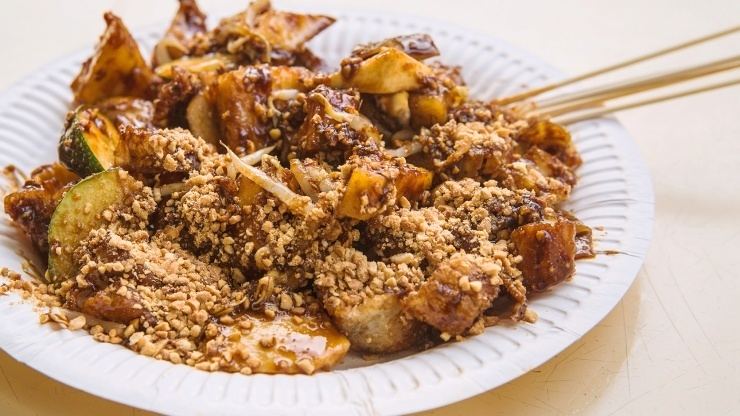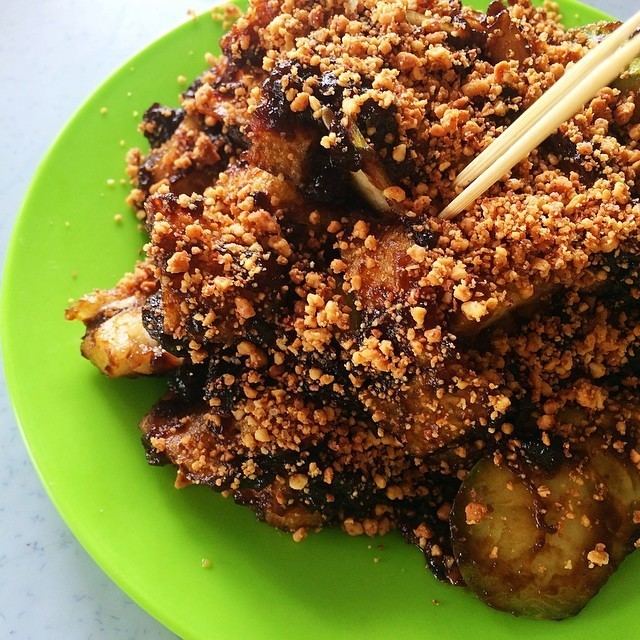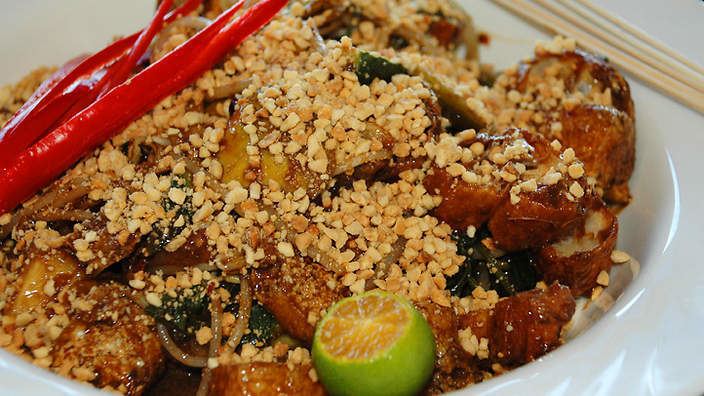Alternative names Rujak | ||
 | ||
Serving temperature fresh in room temperature Similar Bumbu, Sambal, Satay, Cireng, Cendol | ||
Indian rojak sauce
Rojak (Malaysian and Singaporean spelling) or Rujak (Indonesian spelling) is a traditional fruit and vegetable salad dish commonly found in Indonesia, Malaysia and Singapore. Other than referring to this fruit salad dish, the term rojak also means "mixture" or "eclectic mix" in colloquial Malay.
Contents
- Indian rojak sauce
- Chinese rojak
- Origin
- Cultural significance
- Rujak Buah Indonesian fruit rujak
- Rujak Cuka
- Rujak Tumbuk Rujak Bbk
- Rujak Serut
- Rujak u Groeh
- Rujak Pengantin
- Rujak Kuah Pindang
- Rujak Cingur
- Rujak Petis
- Rujak Tolet
- Rujak Juhi
- Rujak Shanghai
- Rujak Soto
- Mamak rojak or Indian rojak Pasembor
- Fruit rojak
- Sotong Kangkung
- References

Rujak is available everywhere across Indonesia, and there are rich variations within the country. However, the most popular rujak variant is rujak buah (fruit rujak), which is mixed sliced fruit and vegetables served with spicy palm sugar dressing. Unlike common fruit salads, rujak is often describes as tangy and spicy fruit salad, due to its sweet, hot and spicy dressing made from ground chili pepper, palm sugar and peanuts. It is a popular street fare in Bali.

Most of Indonesian rujak are made of fresh ingredients; especially fruits and vegetables. Rojak in Malaysia and Singapore however, are mostly of Indian influence mixed with fried tofu, cracker, cruller and fritter. Most of rujak are vegetarian dish which do not contains any animal products, except the sweet and tangy dressing that might contain shrimp paste. Nevertheless, some recipes might contain seafood or meat. Rojak in Malaysia and Singapore usually contain sotong (cuttlefish), while certain rujak recipe in Indonesia might contains seafood or meat.

Chinese rojak
Origin

The origin of rujak is unclear, and there are numbers of rujak variants in Southeast Asia, especially in Indonesia and Malaysia. It is possible that since ancient times, the natives of the Malay archipelago has consumed sour-tasting seasonal tropical fruits—especially Java apple, kedondong and young mango—together with palm sugar and salt, to ease its sourness. In Indonesia, certain fruit plants has their own bearing fruits season, usually within late dry season to the wet season, thus the time of fruit harvest usually coincides with the time of having rujak in Indonesian villages. The fruit species season being anticipated for rujak feast are mango, Java apple and kedondong.

The Javanese in Indonesia has incorporated rujak into their prenatal ceremony called Naloni Mitoni. According to local traditions, young mango and other sour-tasted fruits are craved by pregnant women, apparently as the counterpart of pickles in the West.

The introduction of hot and spicy chili pepper and peanuts must be took place during early colonial era in the 16th century, since those produces were brought by Spanish and Portuguese traders from the Americas. It was suggested that rujak might be related to Indonesian gado-gado, while the rojak in Malaysia and Singapore demonstrate Indian influences with orange-colored peanut sauce as a dip for fried dough and potatoes.
In Indonesia, rujak is a traditional fare, sold in traditional marketplaces, warungs or travelling gerobak pushcart by locals; especially Javanese, Sundanese and Balinese people. In Malaysia, rojak is associated with Mamak stall, which is a Muslim Malaysian Indian foodstall, where Mamak rojak is one of its popular fare. In Singapore, rojak is typically sold by Chinese hawkers. Today, they are sold in most hawker centre in the city.
Cultural significance
In Indonesia, among the Javanese, rujak is an essential part of the traditional prenatal ceremony called tujuh bulanan (literally: seventh month). The ritual was meant to wish the mother-to-be a safe, smooth and successful labour. Special fruit rujak is made for this occasion, and later served to the mother-to-be and her guests, primarily her female friends. It is widely known that the sweet, spicy and sour tastes of rojak are adored by pregnant women. The recipe of rujak for this ceremony is similar to typical Indonesian fruit rujak, with the exceptions that the fruits are roughly shredded instead of thinly sliced, and that jeruk bali (pomelo/pink grapefruit) is an essential ingredient. It is believed that if the rujak overall tastes sweet, the unborn would be a girl, and if it is spicy, the unborn baby is a boy.
Mangarabar, or rujak making, is a special event for the inhabitants of the Batak Mandailing region in Tapanuli, North Sumatra, Indonesia, after the harvest. Normally the whole village will be involved in making and consuming the rujak.
In Malaysia and Singapore, the term "rojak" is also used as a colloquial expression for an eclectic mix, in particular as a word describing the multi-ethnic character of Malaysian and Singaporean society.
Rujak Buah (Indonesian fruit rujak)
Rujak buah is Indonesian fruit rujak, also known as rujak manis (sweet rujak). The typical Indonesian fruit rujak consists of slices of assorted tropical fruits such as jambu air (water apple), pineapple, raw mangos, bengkoang (jicama), cucumber, kedondong, and raw red ubi jalar (sweet potato). Sometimes Malang variants of green apple, belimbing (starfruit), and jeruk Bali (pomelo) are added. The sweet and spicy-hot bumbu rujak dressing is made of water, gula jawa (palm sugar), asem jawa (tamarind), ground sauteed peanuts, terasi (shrimp paste), salt, bird's eye chili, and red chili pepper. All of the fruits are sliced to bite-size, and put in the dish.
The bumbu rujak or thick sweet spicy rujak dressing is poured on the fruit slices. An addition of sambal garam powder (simple mixture of salt and ground red chilli) is put on side as the alternative for those who love a salty taste for their rujak. The Javanese people call this kind of rujak as lotis.
Rujak Cuka
Rujak cuka literally means "vinegared rujak", it is a specialty of Sundanese cuisine of West Java, noted for its sour freshness. It is made of shredded fruits; including young mango, pineapple, jicama, and vegetables; cabbages, beansprouts and cucumber. It is quite similar to asinan, especially its sour and spicy dressing, since both employs vinegar, palm sugar, and chili pepper.
Rujak Tumbuk (Rujak Bèbèk)
This is another variant of Indonesian fruit rujak. The ingredients are almost the same as typical Indonesian fruit rujak, with the exception that all the ingredients are being ground or mashed together (tumbuk or bèbèk in Indonesian) in a wooden mortar. The fruits being ground are young/green pisang batu (a species of banana), raw red yam, jicama, Java apple, kedondong and young unripe mango. The dressing is not poured on the fruit, but already mixed together with all the ingredients. The dressing contains terasi shrimp paste, palm sugar, salt, and birds-eye chili. Traditionally, rujak tumbuk is served in individual smaller portions on banana leaf plates called pincuk, however today it is commonly served in plastic cups.
Rujak Serut
This literally means "shredded rujak", and is another variant of Indonesian fruit rujak. As with rujak tumbuk, the ingredients are similar to Indonesian fruit rujak, with the exceptions that the fruits are not cut into bite-sized pieces, but shredded into a roughly grated consistency.
Rujak u' Groeh
A delicacy from Aceh province, this rujak consists of very young and tender coconut meat, young (green) papaya, bird's eye chili, sugar, palm sugar, ice, salt, and a dash of lime. Best eaten cold.
Rujak Pengantin
"Pengantin" means bride/groom in Indonesian. This rujak is reminiscent of Indonesia's colonial cuisine. It contains slices of boiled eggs, potatoes, fried tofu, pineapple, carrot, bean sprout, pickles, chili, lettuce, cabbage, cucumber, emping crackers, roasted peanuts, peanut sauce and has a little vinegar to it. Some variants mixed the peanut sauce with mayonnaise. It is somewhat like Central Javanese gado-gado.
Rujak Kuah Pindang
A Balinese snack, a variation of the Indonesian fruit rujak, but instead of the normal rujak dressing, the fruits are soaked in a spiced fish broth. The broth consists of terasi (shrimp paste), salt, bird's eye chili, and red chili pepper and fish broth.
Rujak Cingur
Cingur literally means "mouth" in Javanese, cingur (pronounced: "ching-oor") is a variant of rujak from Surabaya. This specialty rujak from East Java has a "meaty" taste. It contains slices of cooked buffalo or cow lips, bangkuang, young raw mango, pineapple, cucumber, kangkung, lontong (rice cake), tofu and tempe, all served in a black sauce made from petis (black fermented shrimp paste, related to terasi), and ground peanuts. It is topped with a sprinkle of fried shallots and kerupuk (Indonesian shrimp crackers).
Rujak Petis
This is another variant of rujak from Surabaya. It contains slices of bangkuang, unripe raw mango, cucumber, kangkung, kedondong, tofu, and soy bean sprouts all served in a black sauce made from petis (sticky black fermented shrimp paste, related to terasi), fried shallots, salt, palm sugar, unripe banana, and ground peanuts. Traditionally it is served on a banana leaf, but today it is more commonly served on plates.
Rujak Tolet
Similar to fruit rujak, and also from Surabaya. Aside from unripe fruits the rojak also includes fried tofu, fried garlic and optionally beef tendons. The sause is a petis based sauce mixed with palm sugar, slices of raw bird's eye chili, and sweet soy sauce.
Rujak Juhi
Juhi means salted cuttlefish in Indonesian; this rujak contains fried tau kwa tofu, fried boiled potatoes, fried shredded salted cuttlefish, cucumber, noodles, lettuce, cabbages, peanut sauce, vinegar, chili, and fried garlic. This dish was originated from Chinese community in Batavia (now Jakarta) and now has become the Betawi dish closely related with Asinan Betawi.
Rujak Shanghai
Named after "Bioscoop Shanghay" (a cinema named after Shanghai, China's most populated city) In Batavia Kota area, this dish was created by Indonesia's Chinese community. This variant of rujak can be found in Indonesian Chinatowns in cities such as Glodok in Jakarta. Rujak Shanghai contains seafood, like Rujak Juhi. Boiled and sliced gurita (octopus) and also edible jellyfish, are served with kangkung (a leafy green water plant commonly used as vegetable), and served with thick red sweet and sour sauce, mixed with pineapple juice, and sauteed ground peanuts. Usually chili sauce and pickled bengkoang are served as condiments.
Rujak Soto
A delicacy from Banyuwangi, East Java, a unique blend between beef soto and rujak cingur. A local specialty in which the vegetables (water spinach and beansprouts) rujak served with lontong rice cake in petis sauce poured with soto soup. It was created in 1975 by Usni Solihin.
Mamak rojak, or Indian rojak (Pasembor)
In Malaysia, mamak rojak (or Pasembur) contains fried dough fritters, bean curds, boiled potatoes, prawn fritters, hard boiled eggs, bean sprouts, cuttlefish and cucumber mixed with a sweet thick, spicy peanut sauce. Traditionally, Tamil Muslim (Mamak) rojak vendors used modified sidecar motorcycles as preparation counters and to peddle their rojak. These mobile vendors now use modified mini trucks. The Pasembor available in Singapore is an assortment of potatoes, eggs, bean curd (tofu), and prawns fried in batter, served with a sweet and spicy chili sauce. In the Northwest Peninsular Region (Penang, Kedah, Perlis, Perak), it is always called pasembor, but in Kuala Lumpur and Singapore it is called rojak.
Fruit rojak
Fruit rojak consists typically of cucumber, pineapple, benkoang (jicama), bean sprouts, taupok (puffy, deep-fried tofu) and youtiao (cut-up Chinese-style fritters). Raw mangos and green apples are less commonly used. The dressing is made up of water, belacan (shrimp paste), sugar, chili, and lime juice. Ingredients vary among vendors with some also using hae ko prawn/shrimp paste, tamarind or black bean paste in the mix. The ingredients are cut into bite-sized portions and tossed in a bowl with the dressing and topped with chopped peanuts and a dash of ground or finely chopped bunga kantan (pink ginger bud).
Rojak Penang is another type of Rojak found in Penang, Malaysia. It is similar to fruit rojak, but adds jambu air, guava, squid fritters and honey to the mixture, emphasizes on the use of tart fruits such as raw mangoes and green apples, and usually omits the bean sprouts and fried tofu puffs. The sauce or dressing for the rojak tends to be very thick, almost toffee-like in consistency and texture.
Sotong Kangkung
Recently sotong kangkung has become so famous in Malaysia, that you can find it at most of the rojak stalls. Sotong kangkung contains sotong (cuttlefish), kangkung (water spinach), cucumbers, bean curds, peanuts, chili and sauce.
